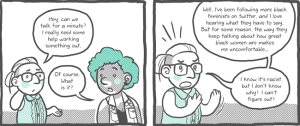Originally published on The Establishment and republished with their permission.
(Content Warning: transantagonistic and cissexist language, mentions of misgendering)
The political left’s search for answers in the wake of Donald Trump’s election began almost immediately after the results were announced.
One of the first targets was transgender people, a group that became the target of conservative ire once the Obergefell Supreme Court ruling came down and marriage equality became law of the land.
The most visible trans issues raised was centered on bathroom rights and whether trans people had the right to use the bathroom of their gender, like everyone else does.
Everyone from Saturday Night Live to the New York Times to the Washington Post joined in, blaming Hillary Clinton’s loss on the fight for a safe place. A seemingly core human rights issue for Democrats had been abandoned in the blink of an eye.
The truth is this is nothing new.
There’s a long history of anti-trans sentiments on the political left, ranging from general unease to outright calls for eradication through denial of transition care.
Trans Exclusionary Radical Feminism
In The Transsexual Empire: The Making of a She-Male, Janice Raymond, a self-proclaimed radical feminist, argues that “[a]ll transsexuals rape women’s bodies by reducing the real female form to an artifact, appropriating this body for themselves… Transsexuals merely cut off the most obvious means of invading women, so that they seem non-invasive.”
This book was released in 1979.
Raymond, who taught women’s studies at The University of Massachusetts—Amherst for decades, wrote the book based on her dissertation under the guidance of prominent feminist Mary Daly.
The Transsexual Empire was definitely not the first instance of transantagonism on the left, but it ended up forming the base of beliefs for modern-day “gender-critical” feminism, which is often referred to as “Trans Exclusionary Radical Feminism” or “TERFism.”
TERFs, like Republican politicians, believe that trans women are really men and that their very existence is a violation of women and a threat. (They are far more concerned with trans women than trans men.)
Prior to the book’s release, gender confirmation surgery was commonly covered by medical insurance for trans women.
But, in 1980, Raymond was asked to write a report for a government-funded body called the National Center for Health Care Technology (NCHCT) on the efficacy of medical treatment for trans people, which ended up as a text called “Technology on the Social and Ethical Aspects of Transsexual Surgery.”
An excellent criticism of the paper by activist Loree Cook-Daniels breaks down Raymond’s argument:
“The NCHCT paper was filled with political and even inflammatory statements. Raymond said medical care of transgender people brought up ‘questions of bodily mutilation and integrity,’ argued that ‘transsexualism is an ethical’ issue, and called for ‘the elimination of transsexualism.’”
This paper was used politically as the basis for Medicare’s blanket exclusion for transgender health care, a ban which was only recently lifted under the Obama administration.
An Obamacare rule also forbids these exclusions for private insurance companies, but the Trump administration has promised to repeal this rule and most of the law.
Both the Right and the Left Deny the Rights of Trans People
The academic opposition to the existence of trans people comes not from the conservative Christians on the right, but from radical feminism on the left.
It’s very rare now to see extreme conservatives working with extreme feminists on any issue, but on the issue of denying trans people and especially trans women their personhood, both groups agree.
Even within LGBTQIA+ political circles, the legitimacy of trans existence is sometimes up for debate.
In the ’60s, trans and queer people could be jailed for wearing clothes of another gender. Laws often required that a certain number of “correctly sexed” articles of clothing be worn to avoid charges of fraud.
This was done to protect the feelings of cisgender straight people, and to ensure that they would never unknowingly compromise their sexualities by expressing attraction to a queer or trans people.
To enforce these laws, police would raid the LGBTQIA+ clubs, which provided queer people with the only safe places to be themselves in those times. Police used social transantagonism to oppress all LGBTQIA+ people for decades before the people began fighting back.
The Stonewall Riots are the most well-known early protests, but typically erased from history are the Cafeteria Riots of 1966.
Both protests began with trans women of color and drag queens finally having enough of the abuse and fighting back. It was the Cafeteria riots and Stonewall that launched the movement for LGBTQIA+ equality, and Pride celebrations commemorate Stonewall.
Yet, even today, there are large sectors of queer people who want to “drop the T” from LGBTQIA+ while forgetting the roots of their own equal rights movement.
Without the actions of a few trans women of color at Stonewall, the gains they’ve made in equal rights may not have happened, and yet trans people are so easily tossed aside by those who should be our closest allies.
Even the movie Stonewall, directed by cis gay man Roland Emmerich, was whitewashed and scrubbed of trans women’s role in the riots.
The Obergefell Supreme Court ruling guaranteeing marriage equality was seen by many on the left as the end of Stonewall’s legacy, but the history of queer protest began with trans women of color, and those same trans women still wait today for equal protection under the law.
Democrats and LGBTQIA+ advocates have a history of stepping on trans rights in pursuit of their own agendas.
In their effort to pass the Employment Non-Discrimination Act in 2007, Democrats dropped gender identity protections altogether in order to reach a compromise with Republicans, and yet the Right killed the bill anyway.
Former US Congressman Barney Frank blamed transgender people for the bill’s failure, accusing them of not lobbying hard enough for the bill.
More recently, the Gill Foundation, a major funder of LGBTQIA+ rights groups, caused a fracture in the ranks of the queer liberation movement when it decided to stop funding the fight against the many “bathroom bills” being proposed across the nation.
Having decided that the public accommodations provisions on nondiscrimination acts are too controversial, it has decided to throw trans people under the bus.
Trans Children Have Been Tossed Aside, Too
Perhaps the hottest debate involving trans issues concerns how to treat transgender children.
This has been hotly debated in the press and in medical circles, and the transantagonistic leftists have been among the loudest voices.
When a children’s gender identity clinic in Toronto was shut down earlier this year for practicing conversion therapy on trans kids, Jesse Singal, a liberal and science editor for New York Magazine, published a 10,000-word defense of the doctor who ran the clinic and his methods.
Singal’s argument boiled down to “conversion therapy for religious reasons is bad, but conversion therapy for academic reasons is good.” His breathless defense of the clinic ignored the many transgender people he interviewed for the piece.
His work and transphobic conclusions on this issue have been lauded by both the extreme Right and Left ends of the political spectrum.
This history – erasing trans women, calling them men and rapists, defending the mistreatment of trans children – set the stage for the current liberal platform: blaming trans people for the downfall of liberalism and the rise of Donald Trump.
***
But the truth is that trans issues aren’t the political poison pill some would have you believe.
Election day turned out pretty bleak for Democrats, but arguably their biggest win was in the race for North Carolina governor – the most expensive governor’s race in North Carolina history and the second most expensive governor’s race of 2016.
In the wake of H.B. 2, no other campaign in the country centered trans issues, and the Democrat Roy Cooper, an outspoken critic of the anti-trans law, pulled out an unlikely victory in a red state that broke for Donald Trump and went easily for Republican senator Richard Burr.
In the face of Republican victories throughout the country, Democrats won a key race in a red state by centering trans rights throughout the campaign.
Embracing trans people and trans rights would bolster the Democratic party, not destroy it – but there are plenty of people on the Left who aren’t interested in seeing that happen.
Trans people generally lean left because we feel that we have to, but we’re also aware that liberalism won’t protect us when the chips are down.
It’s easy to oppose an enemy that is consistently hateful, and at the end of the day trans people know where Republicans stand on whether or not we should exist.
It’s, altogether, more difficult when people who pledge to be your ally end up stabbing you in the back.
[do_widget id=’text-101′]
Katelyn Burns is a trans woman, parent, New Englander, and feminist. Follow her on Twitter @transscribe.
Search our 3000+ articles!
Read our articles about:
Our online racial justice training
Used by hundreds of universities, non-profits, and businesses.
Click to learn more





















